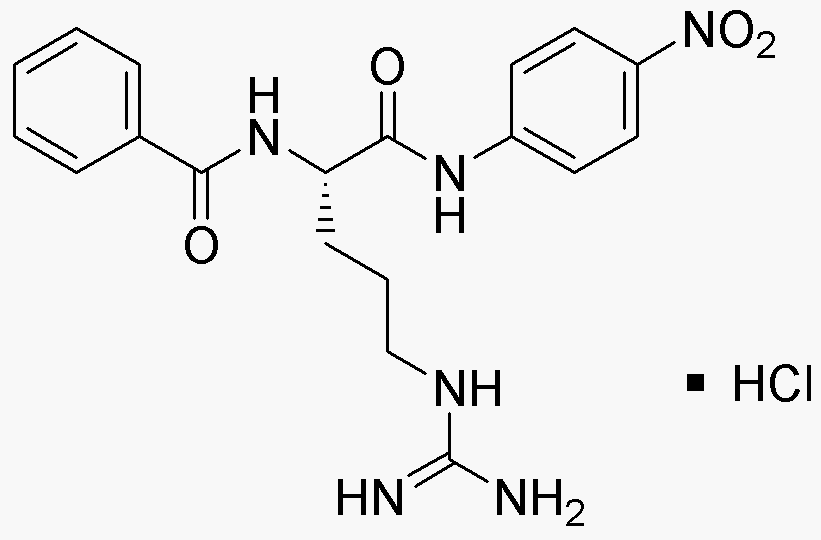Na-Benzoyl-L-arginine 4-nitroanilide hydrochloride is widely utilized in research focused on:
- Protease Inhibition Studies: This compound serves as a valuable tool in studying protease activity, helping researchers understand enzyme mechanisms and develop inhibitors for therapeutic applications.
- Biochemical Assays: It is commonly used in various biochemical assays to measure enzyme activity, providing insights into metabolic pathways and potential drug targets.
- Drug Development: The compound plays a role in pharmaceutical research, particularly in the development of drugs targeting specific enzymes, thereby aiding in the creation of more effective treatments.
- Diagnostic Applications: It can be utilized in diagnostic tests to detect protease-related diseases, offering a means for early diagnosis and better patient management.
- Research on Cellular Processes: This chemical aids in the exploration of cellular processes involving proteases, contributing to a deeper understanding of cell signaling and regulation.
General Information
Properties
Safety and Regulations
Applications
Na-Benzoyl-L-arginine 4-nitroanilide hydrochloride is widely utilized in research focused on:
- Protease Inhibition Studies: This compound serves as a valuable tool in studying protease activity, helping researchers understand enzyme mechanisms and develop inhibitors for therapeutic applications.
- Biochemical Assays: It is commonly used in various biochemical assays to measure enzyme activity, providing insights into metabolic pathways and potential drug targets.
- Drug Development: The compound plays a role in pharmaceutical research, particularly in the development of drugs targeting specific enzymes, thereby aiding in the creation of more effective treatments.
- Diagnostic Applications: It can be utilized in diagnostic tests to detect protease-related diseases, offering a means for early diagnosis and better patient management.
- Research on Cellular Processes: This chemical aids in the exploration of cellular processes involving proteases, contributing to a deeper understanding of cell signaling and regulation.
Documents
Safety Data Sheets (SDS)
The SDS provides comprehensive safety information on handling, storage, and disposal of the product.
Product Specification (PS)
The PS provides a comprehensive breakdown of the product’s properties, including chemical composition, physical state, purity, and storage requirements. It also details acceptable quality ranges and the product's intended applications.
Certificates of Analysis (COA)
Search for Certificates of Analysis (COA) by entering the products Lot Number. Lot and Batch Numbers can be found on a product’s label following the words ‘Lot’ or ‘Batch’.
*Catalog Number
*Lot Number
Certificates Of Origin (COO)
This COO confirms the country where the product was manufactured, and also details the materials and components used in it and whether it is derived from natural, synthetic, or other specific sources. This certificate may be required for customs, trade, and regulatory compliance.
*Catalog Number
*Lot Number
Safety Data Sheets (SDS)
The SDS provides comprehensive safety information on handling, storage, and disposal of the product.
DownloadProduct Specification (PS)
The PS provides a comprehensive breakdown of the product’s properties, including chemical composition, physical state, purity, and storage requirements. It also details acceptable quality ranges and the product's intended applications.
DownloadCertificates of Analysis (COA)
Search for Certificates of Analysis (COA) by entering the products Lot Number. Lot and Batch Numbers can be found on a product’s label following the words ‘Lot’ or ‘Batch’.
*Catalog Number
*Lot Number
Certificates Of Origin (COO)
This COO confirms the country where the product was manufactured, and also details the materials and components used in it and whether it is derived from natural, synthetic, or other specific sources. This certificate may be required for customs, trade, and regulatory compliance.


